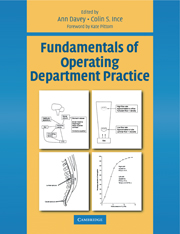Book contents
- Frontmatter
- Contents
- Contributors
- Preface
- Foreword
- Acknowledgements
- Introduction
- Chapter 1 The operating department practitioner, the patient and the law
- Chapter 2 Aspects of health and safety in the operating department
- Chapter 3 The caring practitioner
- Chapter 4 Strategies for infection control in the operating department
- Chapter 5 Sterilization, decontamination and the surgical field
- Chapter 6 The fundamentals of cardiovascular physiology
- Chapter 7 Fundamentals of respiratory physiology
- Chapter 8 Scientific principles in relation to the anaesthetic machine
- Chapter 9 Fundamentals of artificial ventilation of the lung
- Chapter 10 Scientific principles in relation to monitoring equipment
- Chapter 11 Scientific principles in relation to endoscopic, laser and radiological equipment
- Chapter 12 Pharmacological principles of drug administration
- Chapter 13 The pharmacology of drugs used in general anaesthesia
- Chapter 14 The local anaesthetic drugs - does the ideal agent exist?
- Chapter 15 The safe positioning of patients for surgery
- Chapter 16 Principles involved in the management and use of equipment
- Chapter 17 Understanding suture materials
- Chapter 18 Fundamentals ofpaediatric surgery and anaesthesia
- Chapter 19 Fundamentals of hyperthermia and hypothermia
- Chapter 20 Fundamentals of fluid and electrolyte balance during surgery
- Chapter 21 The physiology of blood and its administration
- Chapter 22 Fundamentals of pain relief
- Chapter 23 Fundamentals of dressings and drains in relation to wound healing
- Chapter 24 The recovery of patients from anaesthesia and surgery
- Chapter 25 Fundamentals of emergency and obstetric anaesthesia
- Chapter 26 Identification and management of anaesthetic emergencies
- Chapter 27 The fundamentals of emergency resuscitation
- Appendixes
- Index
Chapter 24 - The recovery of patients from anaesthesia and surgery
Published online by Cambridge University Press: 05 October 2015
- Frontmatter
- Contents
- Contributors
- Preface
- Foreword
- Acknowledgements
- Introduction
- Chapter 1 The operating department practitioner, the patient and the law
- Chapter 2 Aspects of health and safety in the operating department
- Chapter 3 The caring practitioner
- Chapter 4 Strategies for infection control in the operating department
- Chapter 5 Sterilization, decontamination and the surgical field
- Chapter 6 The fundamentals of cardiovascular physiology
- Chapter 7 Fundamentals of respiratory physiology
- Chapter 8 Scientific principles in relation to the anaesthetic machine
- Chapter 9 Fundamentals of artificial ventilation of the lung
- Chapter 10 Scientific principles in relation to monitoring equipment
- Chapter 11 Scientific principles in relation to endoscopic, laser and radiological equipment
- Chapter 12 Pharmacological principles of drug administration
- Chapter 13 The pharmacology of drugs used in general anaesthesia
- Chapter 14 The local anaesthetic drugs - does the ideal agent exist?
- Chapter 15 The safe positioning of patients for surgery
- Chapter 16 Principles involved in the management and use of equipment
- Chapter 17 Understanding suture materials
- Chapter 18 Fundamentals ofpaediatric surgery and anaesthesia
- Chapter 19 Fundamentals of hyperthermia and hypothermia
- Chapter 20 Fundamentals of fluid and electrolyte balance during surgery
- Chapter 21 The physiology of blood and its administration
- Chapter 22 Fundamentals of pain relief
- Chapter 23 Fundamentals of dressings and drains in relation to wound healing
- Chapter 24 The recovery of patients from anaesthesia and surgery
- Chapter 25 Fundamentals of emergency and obstetric anaesthesia
- Chapter 26 Identification and management of anaesthetic emergencies
- Chapter 27 The fundamentals of emergency resuscitation
- Appendixes
- Index
Summary
THE ROLE OF THE RECOVERY ROOM
In a relatively short period of time, operating departments have progressed from providing very little postoperative care to having specially designed recovery rooms. Similarly, in the past, staff were not specifically trained for the role but now there is an increasing trend for permanent staff to possess relevant postbasic qualifications. Recovery staff are trained to observe and monitor patients closely during this early postsurgical period and to take prompt and appropriate action to prevent and/or treat postanaesthetic or postoperative complications. The Royal Colleges of Anaesthesia and Surgery insist on a fully functional recovery area whenever patients are in theatre. Failure to achieve this requirement may well result in the withdrawal of training approval for doctors and nonmedical professionals.
The purpose of the recovery room is to provide a calm, quiet environment, where patients are allowed and assisted to recover from the effects of general, regional or local anaesthesia and surgery. At the end of the recovery period they will be ready to be safely transferred to a surgical ward, where relatively less supervision is required. How long patients remain in the recovery room is unpredictable but it must be at least until they are physiologically and surgically stable. The average length of stay may be 30 minutes to one hour but even comparatively minor operations may result in prolonged recovery periods of several hours because of anaesthetic or surgical problems, which may be due to the type of surgery or anaesthesia or the patient's preexisting condition.
These problems may be predictable or unexpected and patients recovering from surgery therefore have many different needs. It is for this reason that some hospitals have a high dependency unit (HDU) attached to the theatre suite. Patients may be kept in the HDU for several hours (and may also be mechanically ventilated) under expert supervision until they are fit to return to the surgical ward. In this way overnight or short-term admissions to the hospital intensive care unit may be reduced.
The recovery room is designed with several bays orbed spaces, all of which are arranged and prepared in a similar way.
- Type
- Chapter
- Information
- Fundamentals of Operating Department Practice , pp. 267 - 280Publisher: Cambridge University PressPrint publication year: 1999



